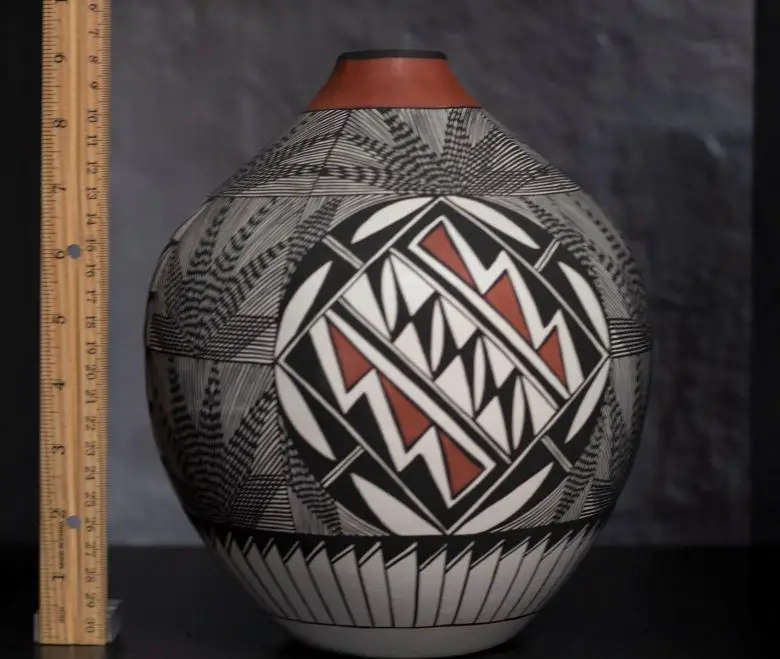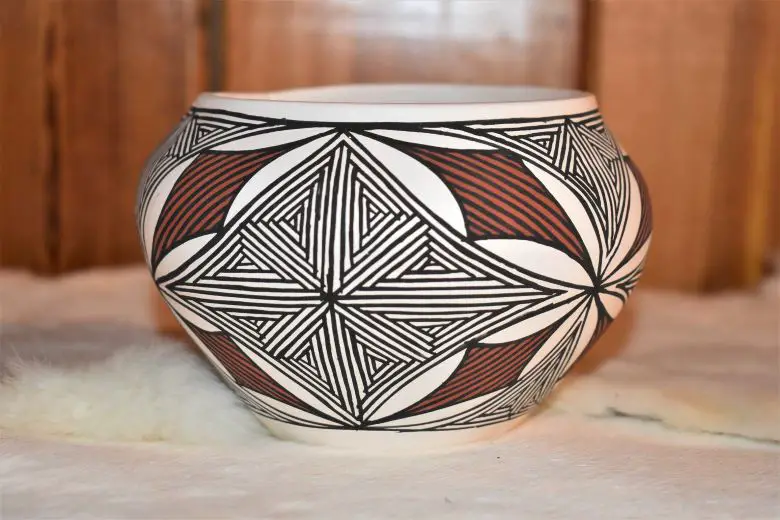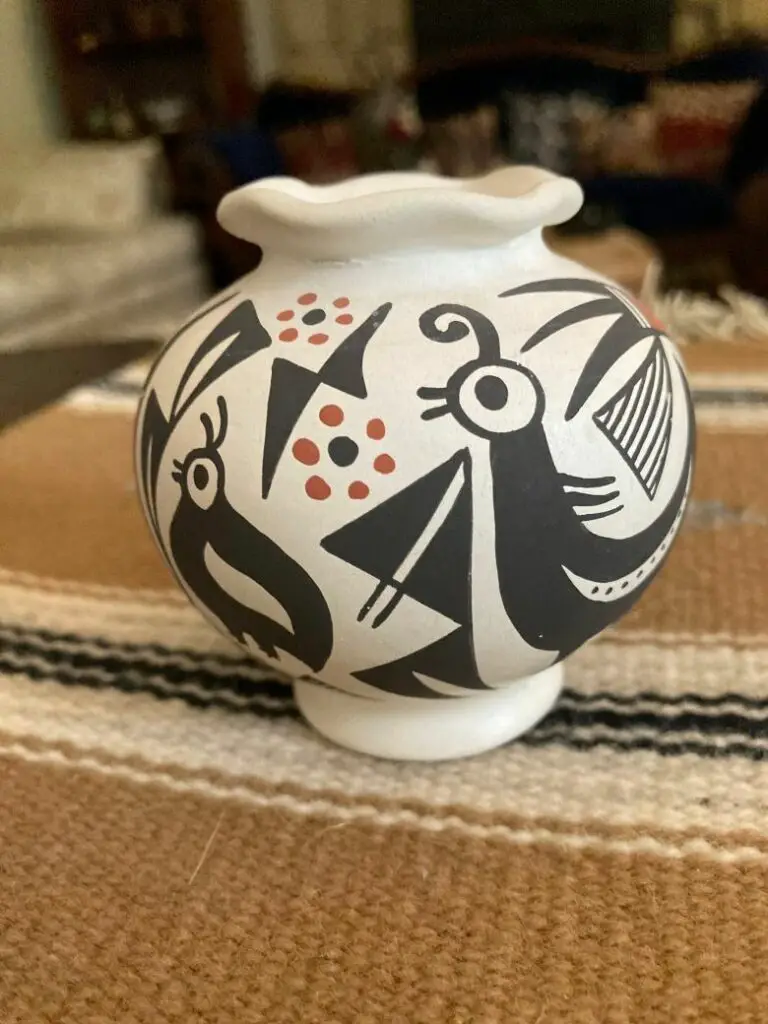Acoma Pottery Identification, Symbols, and Marks

Beyond the fluted rims and slender neck, Acoma pottery has successfully snagged the attention of curators and curators worldwide. The features, no matter how unconventional they are, are their main endearing qualities.
Using techniques as old as the Aztec era, Acoma Pueblo potters manage to create stunning pieces every single time. From getting the clay to preparing it and creating something out of it, the entire process is well-loved and well protected.
Table of Contents
History of Acoma Pottery
In Southwestern New Mexico, settled on a high sandstone plateau is the most established local area in North America. The people of Acoma Pueblo have lived here for a long time, creating a rousing abundance of culture and craftsmanship. The Acoma are part of the Native American Indian people who speak Keresan. They reside in the Mogollon mountain area of New Mexico.
The Acoma pueblo is most popular for its remarkable pottery style and strategy. Employing methods that have been in existence since the Acoma began in 1150 A.D. Perhaps their most prized possession, Acoma pottery is the pride and joy of the Acoma people.
Even though they were made for domestic use, the long, slender neck and fluted rim are endearing.
Like most customary earthenware, the Acoma potters made these articles considered as functional items. For example, utilizing them for capacity, drinking, eating, and other formal purposes.
Acoma Pottery Identification. Acoma Pottery Symbols and Marks
Some symbols used in the designs of Acoma pottery include:
1. Geometric patterns and shapes.
2. Animal motifs and drawings on the pottery.
3. Feathers and birds and water designs.
Where Does Acoma Pottery Come From?
Acoma pottery is created by the Acoma Pueblo people who learned the technique from the Aztec people. Some Acoma designs have also been credited as hailing from other Mexican states.
All in all, Acoma pottery is created by the proud people of Acoma Pueblo, New Mexico.
How is Acoma Pottery Made?
The technique used in making Acoma potteries and ceramics is a traditional process that required diligent precision. The clay is extracted from the slate-like mud that can be found inside the slopes that encompass the Pueblo. This type of clay allows the Potter to create vessels with thin walls using only traditional pottery techniques.
The thin walls are perhaps what has made Acoma pottery as famous as it is today. The clay used in making Acoma pottery allows it to turn out lightweight, yet they are as durable as thin-walled vessels get. The addition of kaolin to the originally grey clay makes it turn out white, rather than grey.
Acoma potters pride themselves on the originality and naturalness of their pottery. To preserve their naturalness, the potters make sure to only use natural pigments and dyes.
To begin with, the mud is extracted, and the preparation process begins immediately. The process of preparation includes removing dirt and impurities, treating the mud so it is permeable and doesn’t recoil. This is achieved with the use of a type of powdered stone or broken-off pieces of broken ceramics.
Next, the clay is covered properly and set aside in a moist environment where it is constantly rehydrated and kept soggy. While the clay is kept on reserve, the potter gathers the pigment needed, all of them from plants and local herbs. When everything is prepared, the potter starts to loop the clay, creating a shape from the base with long ropes made of clay.
When the clay has begun to assume its ideal size and shape, the clay is smoothened carefully. This is done so that both the inside and outside surfaces of the pottery turn out smooth.
Usually, the Acoma potters use gourds for this process simultaneously. While the clay is still malleable and moist, the potter then applies a small amount of slip clay. This process is then finished off using a stone.
Embellishments are painted on this layer with a brush made of a yucca plant. The earthenware is then baked outside, using compost to keep it burning.
Meanings of Acoma Pottery Designs
The major reason for the use of symbols and nature-inspired drawings is because the Acoma people believe in respecting all things as though they were alive.
Acoma pottery features certain peculiar symbols, all of which have their significance to the potter and every other person. Some are:
1. Thin parallel lines running down the pottery signifies rain.
2. Animals signify wisdom, boldness, cunning, strength, music, fertility, speed, healing, etc.
3. Spirals signify continuity and cycles; of life, energy, etc
4. Arrows usually refer to power and/ or direction.
5. Circles signify the earth and/ or celestial bodies.
How is Acoma Pottery Decorated?
The style of Acoma pottery is traditional, with features that are easy for anyone to distinguish. For starters, Acoma pottery is created using a special clay that leaves it thin-walled. The rims of Acoma pottery are also significantly fluted.
Another distinguishing feature of Acoma pottery is the kind of decoration used to give the pottery its final look. Acoma potters use their finer art skills to create geometric patterns, line symbols, and paintings on the vessels they create.
The line drawings and geometric patterns have been noted to bear resemblance to natural elements like rain and animals.
How To Date Acoma Pottery?
Besides the signatures underneath the potteries, the following are two major methods to date Acoma pottery.
1. Smooth-walled items with nature-inspired drawings belong between 1940 and 1950.
2. Potteries with pits and pop-outs on their bodies were created after the 1960s.
Conclusion
Before being relegated to function as ornamental pieces of pottery, Acoma pottery was used for a wide variety of purposes. Before now, they were used to store seeds, water, supplies for farmers and hunters who were going on journeys, etc.
Whether they’re being used as decorative pottery or for functional purposes, Acoma pottery is, no doubt, beyond special. Several Acoma pottery pieces are featured in museums and on shelves of collectors around the world.








